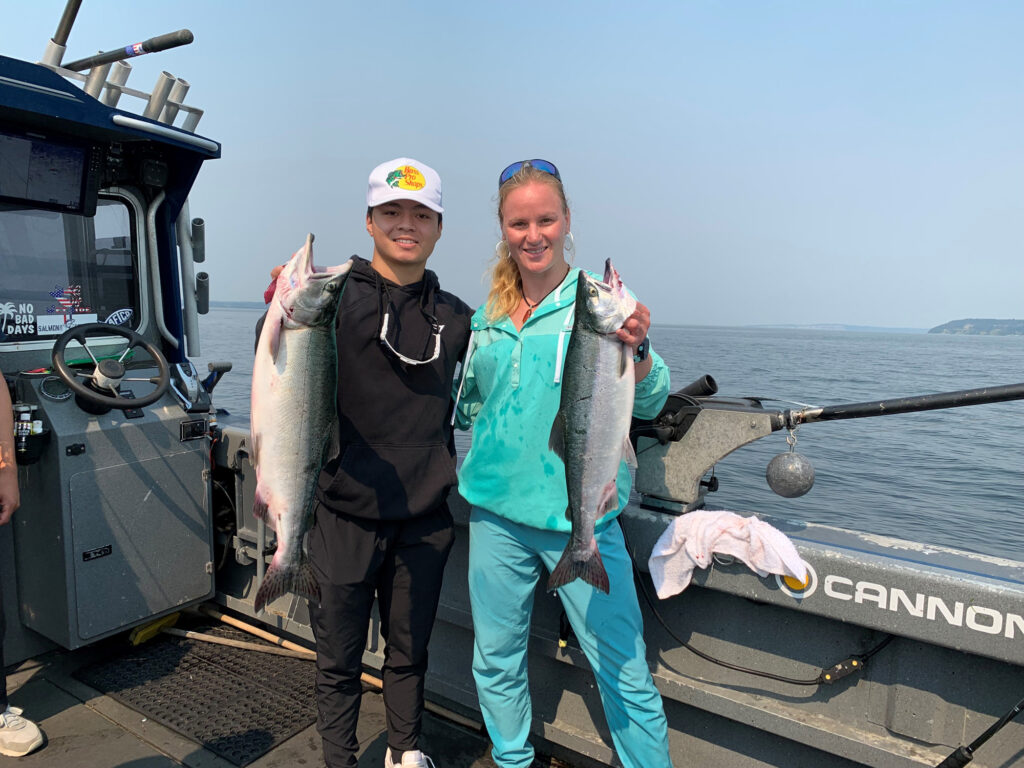
Many anglers will be blushing with excitement as millions of pink salmon arrive during late summer in the Strait of Juan de Fuca and Puget Sound along with a myriad of other salmon fishing options across the state. The Washington Department of Fish and Wildlife has predicted a robust return of 3,950,917 pinks this summer, compared to 2,925,681 in 2021 and 608,388 in 2019. The 2023 forecast is very close to the 10-year average of 4 million. Among the higher predicted river returns are Green, Skagit, Snohomish, Nisqually, Stillaguamish, Puyallup, Hood Canal, and Strait of Juan de Fuca.
While relatively small (3 to 5 pounds), pinks are the fastest growing Pacific salmon species and return in bulk during odd-numbered years after spending two years in the ocean before migrating to natal rivers. The Puget Sound pink run usually peaks in mid-August, and in southern Puget Sound the last week of August and early September are best. Pink fishing in Puget Sound was very good at times in 2021 and 2019 during late summer. Pinks will remain part of daily catch limits in marine fisheries and limits in freshwater areas will be watershed specific.
When targeting pinks, the color of choice is a hot pink lure, spoon, jig or fly as the color resembles plankton or krill that are part of their main diet. Stick with smaller sized mini-squids or small spoons tied behind a short 13- to 16-inch leader to a white-colored dodger or silver flasher. Another method is a smaller 8-inch Pro-Troll flasher with a slightly longer leader of 15 to 20 inches. From boat or shore, casting a Buzz Bomb or Point Wilson jig works well. Let it sink about a foot per second; once you feel the jig go slack, reel up (don’t set the jig hard because pinks have soft jawlines) until you feel the rod bend. Other lures include a pink Rotator trailed behind a small pink plastic “hoochie” squid. Let that flutter down to the desired depth and then slowly retrieve from shore or a boat. The main element to success when fishing from a boat is to troll very slow (1.5 to 2.0 mph depending on current, tide and wind). Pinks like to stay close to the shoreline to avoid strong currents making them easily accessible for bank anglers. Around an hour before and right after a flood tide or a slack tide is the optimal time to catch pinks.
Good pink spots via boat are Possession Bar, Browns Bay, off the Edmonds Marina, west side of Whidbey Island, from Mukilteo south to Shipwreck, Possession Point, Jefferson Head, west side of Bainbridge Island, Richmond Beach, and West Point south of Shilshole Bay. Excellent shore spots include the Mukilteo Lighthouse shoreline and just north at the new ferry pier; Edmonds Pier; Lincoln Park in West Seattle; Carkeek Park; Alki Point; Deception Pass; Golden Gardens; Redondo Beach; Dash Point State Park pier and shoreline; Fort Casey, Keystone, Bush Point and Lagoon Point off the west side of Whidbey Island; Point Wilson and Fort Casey State Park near Port Townsend; Point No Point; Possession Point Bait House; Picnic Point in Edmonds; and Point Defiance Park Boathouse or Les Davis Piers in Tacoma.
Hook Some Chinook or Coho
On the Lower Columbia River at Buoy 10, up to west Puget Sound, the hatchery Chinook and coho fishery is open August 1 through September 4, except for closures on August 21-23 and August 28-29. Fishing along the entire Columbia mainstem up to the Highway 395 Bridge at Pasco also opens for salmon fishing on August 1. Don’t overlook Willapa Bay (Marine Area 2-1), and North Bay in Grays Harbor (2-2) which both open August 1 for hatchery Chinook and hatchery coho. The entire coast should remain open for Chinook and hatchery coho at Ilwaco, Westport, Neah Bay, and La Push provided catch quotas aren’t achieved before the scheduled closing date of September 30. Before heading out the door, check the WDFW website to see what is open or closed and what you can or can’t keep.
Nab Some Crab
Another summer ritual returns this month, as Dungeness crab fishing is now open Thursdays to Mondays of each week through September 4 in the Strait of Juan de Fuca east of Bonilla-Tatoosh Island line off Neah Bay (Marine Area 4), Sekiu (5) and Port Angeles (6); the east side of Whidbey Island (8-1 and 8-2); and northern Puget Sound (9). The Central Puget Sound (10) crabbing season is open on Sundays and Mondays of each week through September 4 and south-central Puget Sound (11) crab fishery is open on Sundays and Mondays of each week through August 28. Crabbing in Hood Canal (12) north of Ayock Point is open on Thursdays through Mondays of each week through September 4; and in the San Juan Islands (7 South and 7 North) it is open on Thursdays through Mondays of each week all the way through September 30.
Be sure crab pots are properly weighted down during big tidal exchanges to avoid traps moving or becoming lost. Learn how to properly weight crab pots, by going to the Northwest Straits Commission website at: nwstraits.org/our-work/catch-more-crab/. Also avoid deploying crab pots and gear in ferry lanes which have caused serious damage to ferry boats in the past. For specific crabbing regulations and other rules, go to: wdfw.wa.gov/fishing/shellfishing-regulations/crab.
In the next issue of the magazine, I’ll dive into September coho salmon fishing options. I’ll see you on the water very soon!